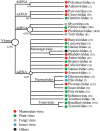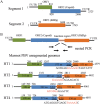Marmota himalayana in the Qinghai-Tibetan plateau as a special host for bi-segmented and unsegmented picobirnaviruses
- PMID: 29511159
- PMCID: PMC5841229
- DOI: 10.1038/s41426-018-0020-6
Marmota himalayana in the Qinghai-Tibetan plateau as a special host for bi-segmented and unsegmented picobirnaviruses
Abstract
Wildlife has been considered the main source of novel viruses causing emerging infectious diseases. Marmota himalayana is endemic to the Qinghai-Tibetan Plateau, China. Here, based on a high-throughput method using Illumina RNA sequencing, we studied the RNA virome of M. himalayana and discovered multiple novel viruses, especially picobirnaviruses (PBVs), which have a bi-segmented genome and belong to the family Picobirnaviridae. A total of 63% of the viral contigs corresponded to PBVs, comprising 274 segment 1 and 56 segment 2 sequences. Unexpectedly, four unsegmented PBV genomes were also detected and confirmed by PCR and resequencing. According to the phylogenetic analysis, the following nine PBV assortment types are proposed: C1:GI, C2:GIV, C4:GI, C4:GV, C5:GI, C7:GI, C8:GIV, C8:GV and C8:GII. We hypothesize a model of segmentation for the PBV genome, mediated by a 6-bp direct repeat sequence, GAAAGG. The model is supported by detection of the segmentation-associated sequence GAAAGG not only in the 5' untranslated regions of segment 1 (221 in 289) and segment 2 (57 in 80) of bi-segmented PBVs but also in the 5' untranslated regions and junction sequences between the capsid and RdRp genes of unsegmented PBVs. Therefore, with RNA sequencing, we found an unexpected biodiversity of PBVs in M. himalayana, indicating that M. himalayana is a special host for PBVs. We also proposed a putative model of how bi-segmented PBVs could be converted into unsegmented PBVs, which sheds new light on the processes of RNA virus genome evolution.
Conflict of interest statement
The authors declare that they have no conflict of interest.
Figures





References
MeSH terms
Substances
LinkOut - more resources
Full Text Sources
Other Literature Sources
Research Materials
Miscellaneous
